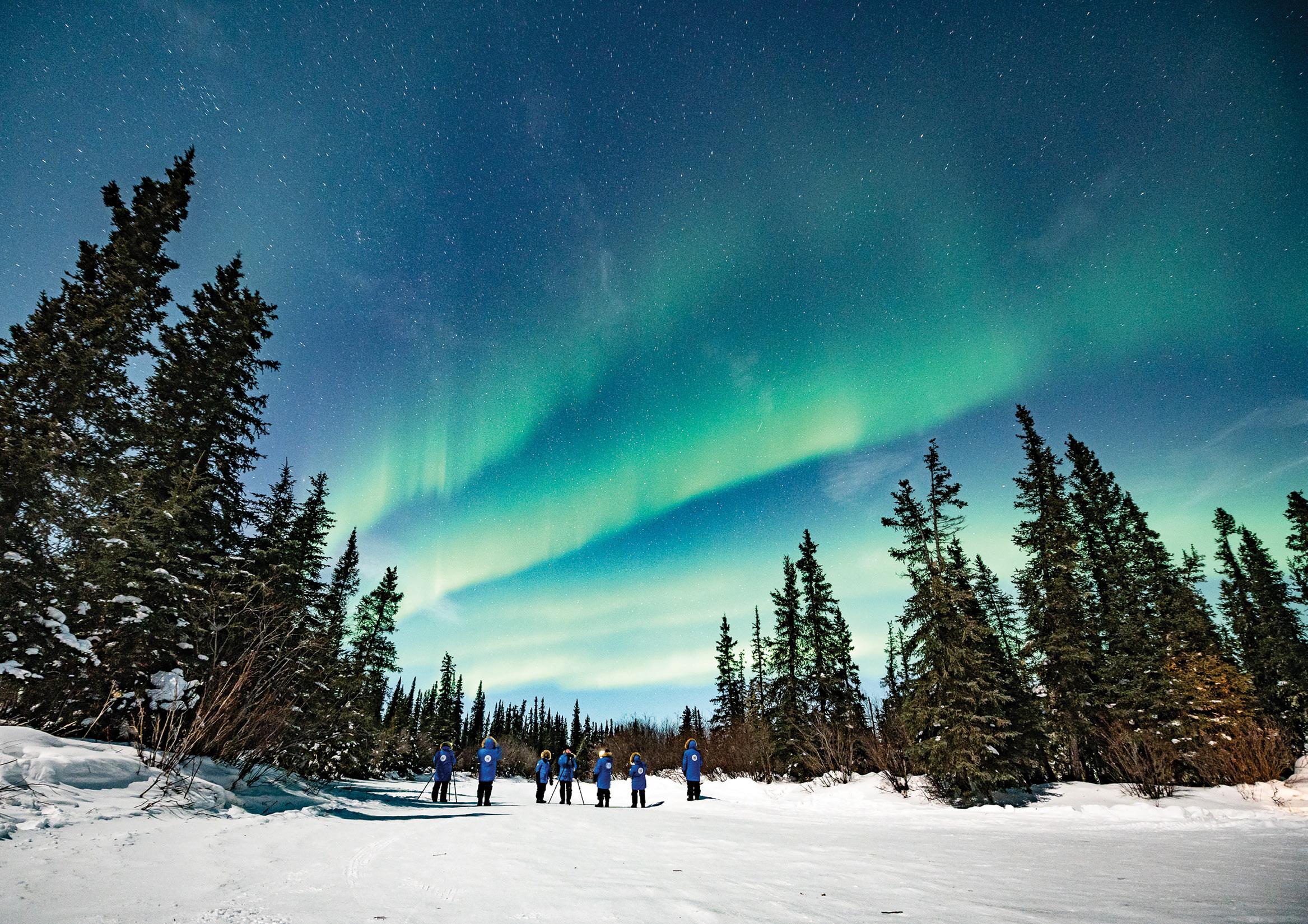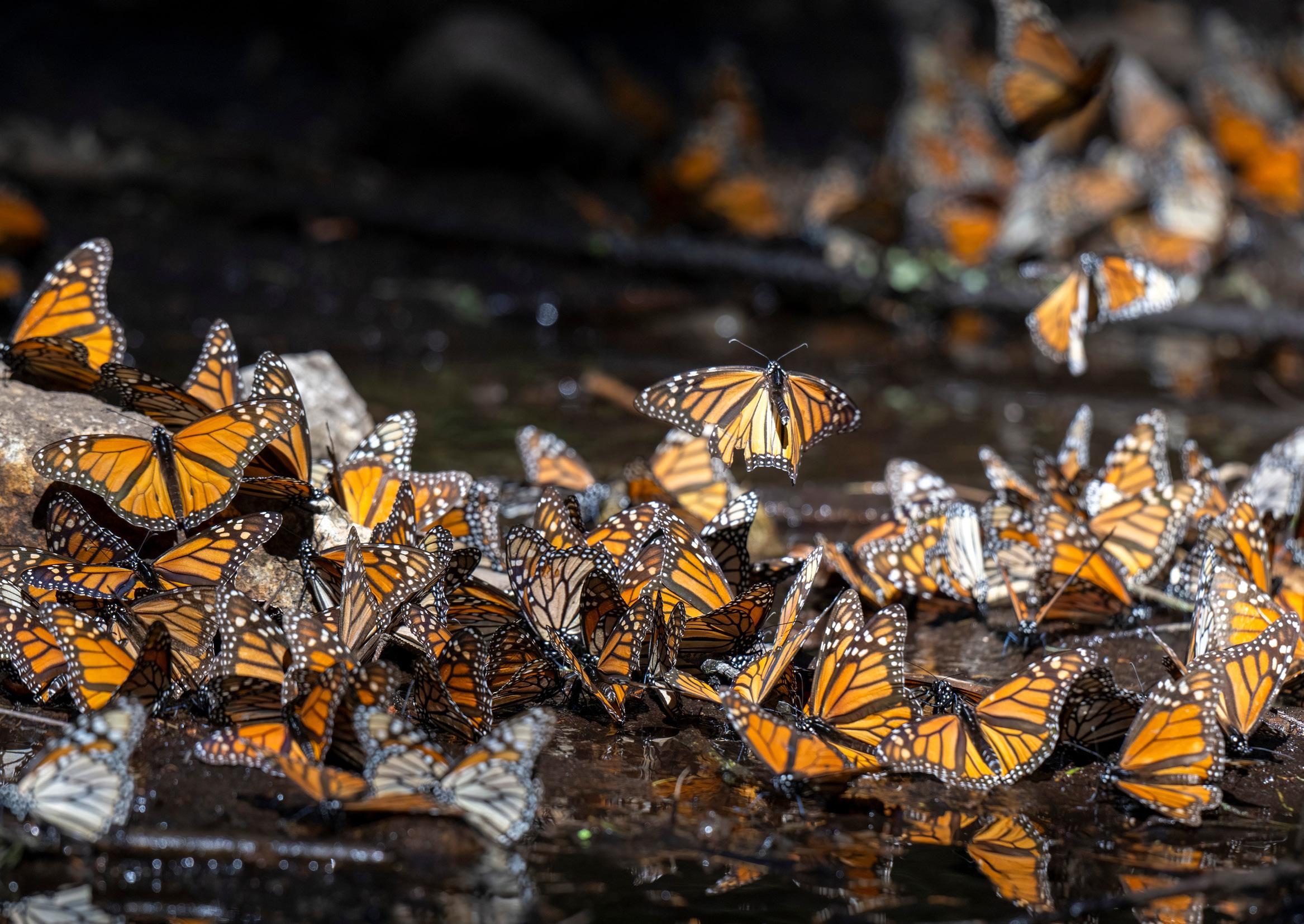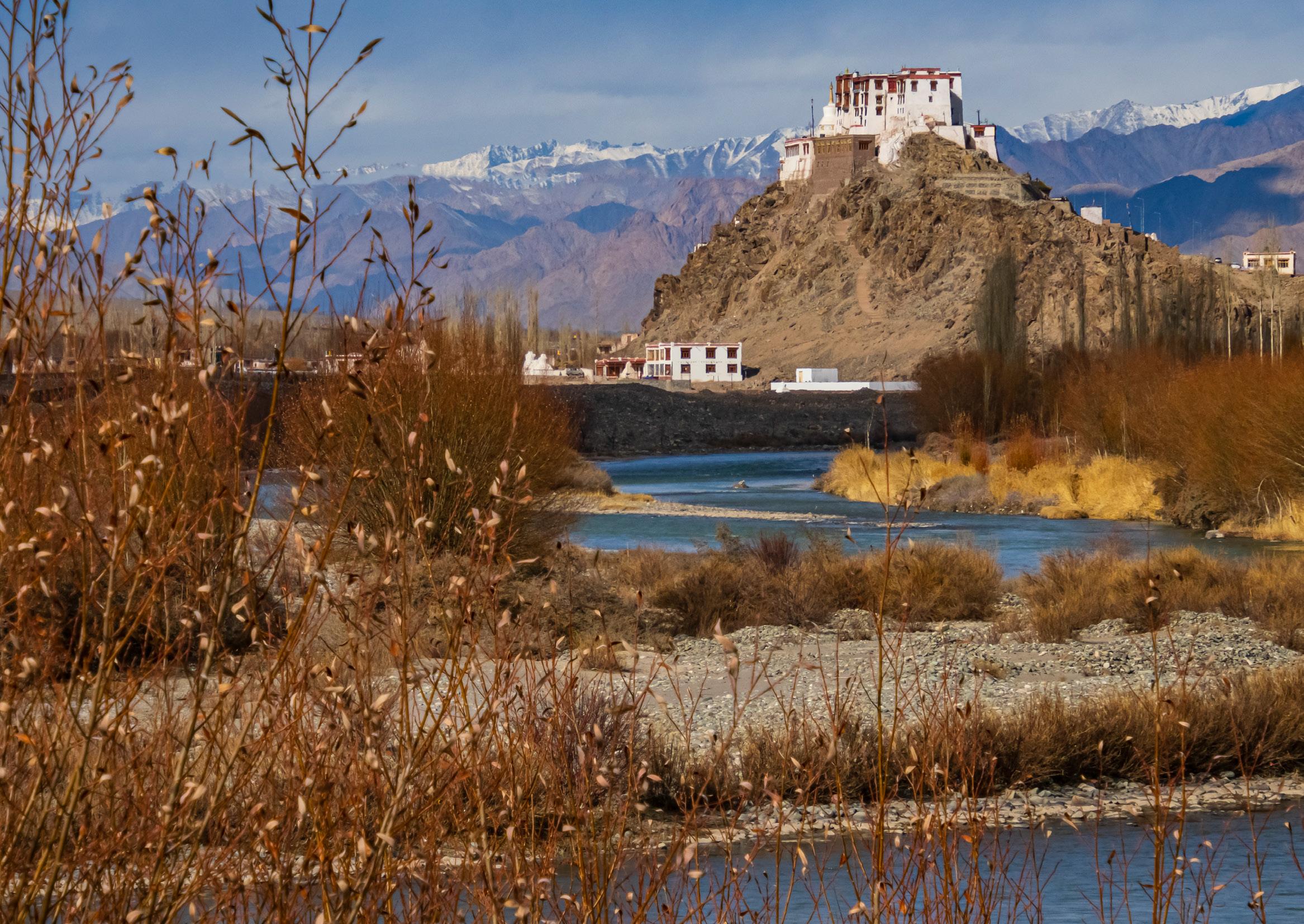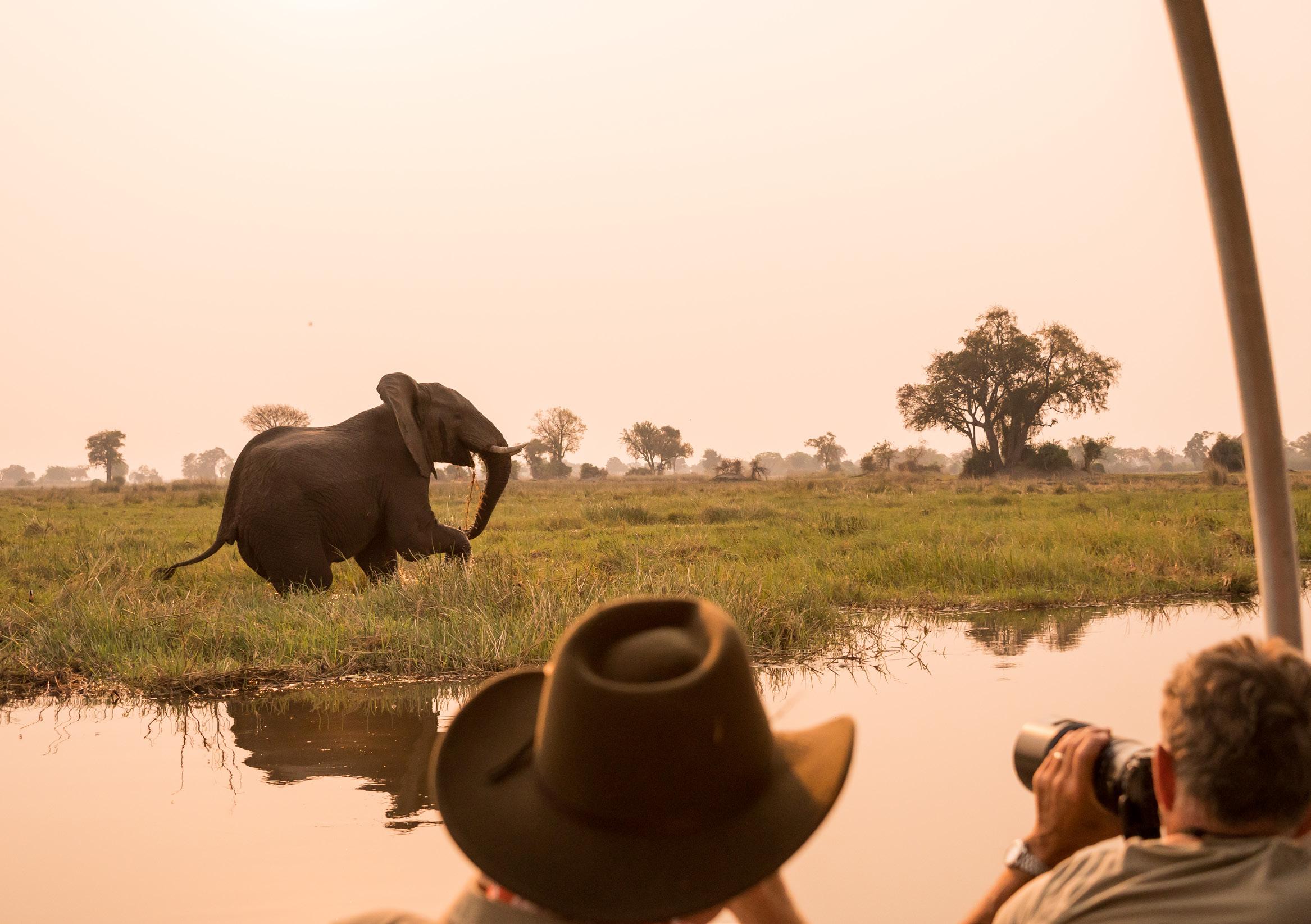






Since 1985, Nat Hab has delivered life-enhancing nature and wildlife experiences to small groups of passionate explorers. We combine an innovative approach to travel, personal attention to detail, and industry-leading sustainability practices to provide intimate encounters with Earth’s wildest places. Our mission is conservation through exploration—protecting our planet by inspiring travelers, supporting local communities and boldly influencing the entire travel industry.
Our Expedition Leaders are the most highly trained naturalist guides in the industry, sharing expert interpretation along with personal attention to each traveler. And our distinctive
lodgings are integral to a matchless nature immersion, offering proximity to wildlife and exceptional comfort in an unobtrusive context. Averaging just nine guests, our groups are the smallest in the industry, facilitating quiet opportunities for close-up, meaningful interactions with wildlife.
Our passion is to help travelers rediscover their connection to the natural world, while protecting it in the process. We cater to a distinct kind of guest: one who shares our love for this planet, who is a seeker of life-affirming experiences, and who considers nature home—where you go to feel your most connected, inspired and alive.
You’ve no doubt had moments in nature that have filled you with wonder. Since founding Natural Habitat Adventures, I have had the good fortune to experience my fair share of such moments: Exchanging an intelligent gaze with a mountain gorilla in Rwanda. Crawling inside a vacant polar bear den on the Canadian tundra. Snorkeling with inquisitive sea lions in the Galapagos. What I felt in each of these instances is an emotion that has captured the recent interest of scientists: awe.
Psychologists have found positive effects when humans experience awe. Awe triggers oxytocin, which calms the nervous system. It makes people feel small, prompting them to redirect concern away from the self and toward the wider world.
Researchers have discovered that people find awe in nature more than any other context. And that’s good news for conservation and the well-being of the Earth!
I would venture that the best thing about traveling with Nat Hab is the chance to experience awe. Where will you find it?
I hope to see you out there,
Ben Bressler
Explorer, Founder, President Natural Habitat Adventures
4
Getaways to Embrace— or Escape—the Cold
14 SPRING Nature Adventures to Celebrate Spring
22 SUMMER Adventures for Nature Lovers
28 AUTUMN Fall Foliage Adventures
• The Contents listed above are live links. Click to jump to the desired page.
• Click “CONTENTS” in the lower right corner to return to this Contents page.
• Other links throughout the e-book are shown in blue, underlined text.

When mercury’s dropping, snow is in the air and Orion rules the night sky, all signs point to winter—the season that induces cabin fever like no other. It’s time for a vacation, and whether you’re hoping to embrace the cold or slip off to sunnier climes, Natural Habitat Adventures has you covered. Will it be watching the northern lights in the Great White North? Or following monarch butterflies to their overwintering site in Mexico? Whichever path you choose, you can’t go wrong. All our trips are carbon-neutral, travel in small groups and are led by conservation-first Expedition Leaders. They’re also developed in concert with our partner, World Wildlife Fund, so whatever the weather, you can help protect nature, support local economies and preserve local cultures in the places we travel.
1. Manitoba, Canada Light Out for the Great White North
2. Mexico’s Central Highlands Be Mystified by Monarchs
3. The Himalayas Keep Company with Some Pretty Cool Cats
4. Antarctica Sail the White Continent
5. Yellowstone National Park Skip the Summer Crowds
6. Mexico’s Baja Peninsula Get Acquainted with Gray Whales

Churchill’s long winter nights, clear skies and coveted real estate below the Van Allen radiation belt—a celestial zone teeming with highly charged particles—make it the Broadway of aurora borealis viewing. But trust us: The best shows are those seen from heated theaters.
On Nat Hab’s Northern Lights & Arctic Exploration adventure, travelers can watch the spectacle from a wood stove-warmed cabin in the woods, a custom-built glass Aurora Pod® with 360-degree views of the night sky, geodesic Aurora Sphere, Aurora Domes and a toasty teepee with a cozy campfire. The trip’s traditional dog sled rides, snowshoeing excursions and cultural encounters with First Nations, Metis and Inuit peoples are equally illuminating.
GOOD TO KNOW
Amid the Arctic’s record-paced warming, WWF collaborates with local communities and Indigenous groups in the region to establish protected areas, develop renewable energy systems and promote sustainable fisheries.

© H Davis
Monarch butterflies’ annual wintering in central Mexico’s fir forests is “one of the most spectacular things you’ll ever see,” says Court Whelan, Nat Hab’s director of sustainability and author of The Monarch Migration: A Journey through the Monarch Butterfly’s Winter Home. It’s also one of the most spectacular things you’ll ever hear. “They sound like rustling leaves as they take flight by the millions,” he adds.
Three visits to locally managed sanctuaries in Mexico’s Monarch Butterfly Biosphere Reserve provide sufficient time to fill your senses on Nat Hab’s Kingdom of the Monarchs adventure—and learn how butterfly conservation creates sustainable economic opportunities while saving forests.
Nat Hab’s trip “not only helps promote the ecotourism concept by leaving money in local communities, but it also builds awareness,” about this endangered species, says Whelan. WWF’s monarch outreach includes partnering with local governments and communities to protect Mexico’s hibernation grounds.

It’s the ultimate “peak” adventure. Nat Hab’s Land of the Snow Leopard adventure takes travelers high into the Himalayan landscape of Ladakh in search of this wildly elusive feline. Masterfully camouflaged against their mountain terrain, snow leopards are super athletes, capable of sticking to the steepest of slopes, sprinting up to 40 miles per hour and leaping six times their body lengths. Fortunately, our local guides double as expert trackers, meaning there’s a solid chance of sightings on your journey. Pro tips for spotting Panthera uncia: Keep your eyes peeled and your head up!
Additional trip highlights include staying in a private mountain ecolodge and tapping into Tibetan Buddhist culture on visits to local villages and monasteries.
Preventing poaching and reducing human-wildlife conflict are among WWF’s top priorities for snow leopards, whose numbers are estimated to be as low as 4,000 across Central and South Asia. Nat Hab also makes a donation to the Snow Leopard Conservancy India Trust for each traveler on this trip.

The ultimate winter wonderland, Antarctica wows with impossibly blue icebergs, a menagerie of migrating seabirds and marine life, and—ideally—a sublime solitude. That’s why Nat Hab’s preferred way to see the Seventh Continent is on a small sailing vessel (read: not a larger cruise) with only seven guests. Voyaging aboard an ice-strengthened motorsailer, travelers on our Sailing Antarctica: A Polar Wildlife Expedition can experience The Ice at its most wild.
During your trip, you’ll also set out on the quietest of kayaking excursions, learn from the ship’s naturalists and spend time ashore, including up to three nights camping in a remote location you can truly call your own.
GOOD TO KNOW
WWF collaborated with Apple to create the citizen science app Wildcrowd, which lets travelers and naturalist guides record wildlife sightings on the White Continent, in part to heighten understanding of how climate change affects animal feeding habitats.

For most travelers, summer’s typically the first season that comes to mind when planning a visit to America’s first national park. But here’s a secret: Winter in Yellowstone is especially sublime.
“It’s my favorite time to be in the park,” says wildlife biologist Aaron Bott, who joins Nat Hab trips to speak about wolf ecology. No wonder: Geysers steam, snow-covered expanses sparkle and a slew of wildlife stands out against the park’s wintery terrain. Sans summer crowds, visitors also have more room to take it all in, particularly on Nat Hab’s small-group Yellowstone: Ultimate Wolf & Wildlife Safari. Guests track wolf packs with biologists in Lamar Valley, pilgrimage by private snow coach to Old Faithful (inaccessible to regular vehicles in winter) and meet professional nature photographer Dan Hartman at his gallery in nearby Cooke City.
GOOD TO KNOW
To help safeguard Yellowstone National Park’s genetically important bison (preserving genetic diversity is essential to the species’ survival), WWF’s Northern Great Plains Program works with Native American reservations to bring portions of the park’s source bison herd into additional reserves.

Monarchs aren’t the only species in on the secret. Gray whales also flock to Mexico each winter, swapping frigid Alaskan seas for Baja’s warmer waters—and their buffets of plankton blooms. Their annual return to their feeding and breeding grounds—our planet’s longest mammal migration—is also a boon for travelers on Nat Hab’s Great Gray Whales of Baja adventure. Count on plenty of close encounters with these friendly giants, who often swim alongside skiffs and dazzle with their breathtaking breaches.
You’ll also love staying in “whale cabanas” at a waterfront eco-camp in San Ignacio Lagoon and surveying salt flats at El Vizcaino Biosphere Reserve.
GOOD TO KNOW
Pods of gray whales wintering in San Ignacio Lagoon get routine “checkups” from a WWFsupported research team, which monitors their population size and health.

Spring forward from so-called winter woes into a season full of possibilities! From wildflowers to wildlife, this time of year offers travelers great weather, fewer crowds and blooming landscapes. And with a Nat Hab trip, you can always rest assured that you’ll be traveling in a way that helps—rather than hurts—the planet, no matter the destination.
Here are four fantastic spring getaways that are sure to put a spring in your step!
1. The Cotswolds
Explore English Nature
2. Botswana
Photograph African Wildlife
3. India Encounter Bengal Tigers
4. Galapagos Islands
Snorkel with Sea Lions and Stay in Wild Tortoise Terrain

A visit to the classic British countryside provides a change of scenery—happy sheep, rolling hills and stone cottages—and an invitation to enjoy the heritage and architecture of an area protected as Britain’s largest National Landscape. The Cotswolds include a collection of picturesque towns and villages, luxury inns surrounded by pristine meadows, and unspoiled rural beauty that’s rare to find preserved as it has been here.
With Nat Hab, you benefit from private tours and special access to estates, farms, gardens and local food purveyors. The Slimbridge Wetland Center here, also referred to as the “avian Serengeti” is a nature reserve established to protect birds and their habitat. Endangered and rare bird species are also bred at the center to later be released into the wild.
GOOD TO KNOW
Our focus is on native habitats, artisan agriculture and conservation in Britain’s largest designated National Landscape.

Head to Botswana to observe intimate animal encounters via 4×4 game drives in Mosi-oa-Tunya National Park, Linyanti Private Reserve and the Okavango Delta. You also get to witness Victoria Falls as it thunders above the Zambezi Gorge, and your special access to a predator researcher at Nat Hab’s Gomoti Camp makes this an experience to remember.
Did we mention that Botswana is one of five countries that participate in the Kavango–Zambezi Transfrontier Conservation Area, the world’s largest transboundary conservation area, an unprecedented treaty facilitated by World Wildlife Fund. KAZA is home to half of Africa’s elephants, the majority of which are in Botswana.
GOOD TO KNOW
Our own exclusive small camps on uncrowded private reserves offer remote settings, unsurpassed comfort and astounding proximity to wildlife.

Spotting wild cats in the untamed outdoors is an adrenaline rush like no other. If you’ve always wanted to observe lions, tigers and other big cats in their natural surroundings, consider joining Nat Hab on a trip to India’s Ranthambore National Park. The spring season is great for other animal sightings as well, so you may encounter leopards, sloth bears, chitals and more. Our secret weapon is our seasoned Expedition Leaders who are professional animal trackers and experts at finding the best spots for viewing wildlife.
Ranthambore is one of the top conservation spots in India, with the Bengal tiger population steadily on the increase. Your travel dollars spent here aid in the preservation of tiger populations through responsible ecotourism efforts.
Ranthambore is also offers chances to spy sloth bear, caracal, jackal, striped hyena, desert fox, mongoose and more.

Marine iguanas, blue-footed boobies and sea lions are but a few of the animal species you can find in abundance in the Galapagos. Ascend from the sea into the highlands of Santa Cruz to reach Nat Hab’s exclusive Tortoise Camp. Amid lush Scalesia forest and subterranean lava caves, travelers have an intimate encounter with nature found nowhere else in the Galapagos. The islands are a premier nature travel destination, and you’ll understand why when you see the pristine swaths of land and ocean that await.
The Charles Darwin Research Station is also located here, part of conservation efforts spearheaded by WWF. The nonprofit conservation organization is involved in wildlife monitoring, innovative fisheries management and implementing sustainable tourism to protect the area’s natural resources.
GOOD TO KNOW
The smallest groups and best guide-togroup Ratio (1:7)! The typical ratio for most Galapagos boat tours is 16 guests to one naturalist guide. Nat Hab’s ratio is one guide for just seven guests.

Dive into the heart of summer with one our thrilling experiences and deepen your connection to our planet’s diverse ecosystems. Navigate Portugal’s scenic rivers, where paddling blends with visits to local wineries, offering a taste of both nature’s beauty and cultural richness. Journey to the windswept Scottish Highlands, where ancient landscapes reveal rare wildlife and centuries-old traditions. Witness the annual congregation of beluga whales in Manitoba, a spectacle that underscores the delicate balance of Arctic ecosystems. Finally, explore the breathtaking canyons of the American Southwest, where towering cliffs and desert vistas showcase nature’s grandeur and the importance of preserving our landscapes.
1. Croatia & Slovenia
Explore the Alps and Adriatic Coast
2. Portugal
Paddle the River of Wine
3. Scotland
Wander Wild Highlands & Islands
4. Manitoba, Canada
See Belugas, Bears & Summer Wildlife
5. The American Southwest
Gaze Upon the Grand Canyon, Bryce & Zion

Discover little-known corners of Europe and explore the Adriatic Coast and Europe’s easternmost Alps on an intimate nature journey through two diverse Balkan countries. In Croatia, enjoy a private boat cruise to view a colony of rare griffon vultures and admire rocky headlands, turquoise bays and red-roofed villages. In Slovenia, ride a mountain cable car and wander alpine trails among wildflowers and wildlife like ibex and chamois.
Cultural heritage is a rich part of this trip, as we visit ancient Roman sites and traditional farms continuing sustainable artisan production of wine, honey and cheese.

Kayak the mellow Douro River through Portugal’s historic port wine region by day...then relax and feast at classic vineyard estates each night! Meet the Old World culture of rural Portugal that few encounter. Summer departures offer verdant vistas and flowers, while autumn is harvest time.
GOOD TO KNOW
Enjoy local hospitality in luxurious boutique inns on vineyard estates, joining family hosts for indulgent repasts of classic Portuguese cuisine and wines.

From the Outer Hebrides with their huge seabird colonies to the ancient Caledonian forests of the interior where red deer and pine marten play, wild Scotland entices. Alongside top naturalists, discover lochs, whales, seabirds, wildflowers, granite islands and prehistoric cultures.
GOOD TO KNOW
Ride the Jacobite Steam Train through the Highlands and enjoy first-class passage on this stunning 42-mile rail journey through glens, lochs and Britain’s highest mountains.

If the Northland holds an allure for you, come on up to Hudson Bay where the boreal forest meets the Arctic tundra and wildlife abounds. You’ll meet hundreds of friendly beluga whales up close in the Churchill River. We also search for caribou, Arctic fox, even polar bears, on this epic Canadian adventure. And even better news, Manitoba province in Canada has recently released a plan with recommendations on how to protect belugas that migrate to Manitoba’s western Hudson Bay coastline, which we hope means they will continue to migrate to these waters for years to come.
GOOD TO KNOW
Search for polar bears and caribou by helicopter, on a scenic flight over the tundra and taiga forest as we survey the vast expanse of this roadless wilderness on Hudson Bay.

If you’ve always wanted to witness the awe-inspiring vistas of the American Southwest, come explore canyon country with us. Our small-group immersion in Bryce, Zion and Grand Canyon reveals lesser-known parts of these iconic parks, as our naturalist Expedition Leader fills in every facet of the region’s history, geology, wildlife and culture.
Enjoy coveted stays at special lodgings replete with history, Old West atmosphere and exceptional proximity to nature, outdoor adventure and national park highlights.
GOOD TO KNOW
Witness the geological drama and get thrilling aerial photos of Bryce Canyon’s pink sandstone hoodoos on a 30-minute helicopter flight.


On its finest days, summer feels like it could last forever. But, alas, all good things must come to an end. Or, when it comes to the seasons, sublimely shift into something new. As F. Scott Fitzgerald famously said, “Life starts all over again when it gets crisp in the fall.”
Deciduous trees know this best. Signaled by autumn’s softer temps and shortening days, they stop photosynthesizing and, in preparation for winter, draw nutrients from their leaves into their roots. Glorious greens, colored by chlorophyll, give way to yellow xanthophyll and orange carotenoid, pigments previously concealed. Deeper autumn days spur additional chemical processes that rouse red and purple pigments called anthocyanins. In lay terms, trees don new clothes and, in the process, put on one of nature’s finest and most flamboyant shows.So, break out those merino wool sweaters and top off your thermos with hot cider. It’s time to go leaf-peeping.
1. Maine See Peak Views in the Poplar Tree State
2. Yellowstone Fall in Love with America’s First National Park
3. Iceland Circle the Land of Ice & Fire
4. China A Nature Odyssey

Maine may be known as the Pine Tree State, but come autumn, the fiery poplars, beeches, maples and oaks that help define its deciduous forests all lobby fiercely for a moniker change. Nat Hab travelers can see them make their case on Maine Coastal Explorer. Take in the colors while sailing aboard a historic windjammer in Camden’s Penobscot Bay and strolling along the sylvan shorelines of Deer Isle. The “Maine” event: leaf peeping within the 47,000 protected acres of woodlands, mountains, lakes and coastlines that comprise Acadia National Park.
GOOD TO KNOW
Look for weathered, whitewashed barns while meandering on Highway 1 along Penobscot Bay and the Blue Hill Peninsula; multihued buoys during a cruise around Mount Desert Island aboard a working lobster boat and— even better—bright crimson lobsters while dining at Deer Isle’s eighteenth-century Pilgrim’s Inn; and a pretty pink sunrise lighting up Bar Harbor from atop Cadillac Mountain, Acadia’s highest peak.

How do we love Yellowstone National Park in the fall? Let us count the ways: 1. fewer visitors (summer crowds to America’s first—and most visited—national park have thinned out); 2. better photo ops (fewer people means less likelihood your Old Faithful pics will be photobombed); 3. increased wildlife sightings (many species are on the move while preparing for winter); and 4. brilliant bursts of fall colors (think red-leafed shrubs, golden aspens and bright yellow cottonwoods).
We travel with expert local naturalists who know where to find the best wildlife enclaves, away from the crowds. We’ll look for herds of bison and bugling elk among golden aspens and grizzly bears feasting on berries. Nat Hab’s small-group Hidden Yellowstone & Grand Teton Safari provides ample time—and space—to absorb it all within the park’s remote corners and off-the-radar spots.
Look for brown bears along the shores of Yellowstone Lake; gray wolves in the Lamar Valley while getting the facts about this keystone species from wolf biologists; and millions of microscopic thermophiles that dye the park’s hydrothermal features in a kaleidoscope of colors.

Shorter fall days and changing temperatures transform Iceland’s green summer tundra into a stunning display of gold and crimson hues. These autumn colors stand in stark contrast against pewter cliffs and mountains, rugged coastlines and hardened lava. Dark skies return after a bright Arctic summer, and with them comes the potential to see the northern lights. Wildlife encounters center around whales and elusive mammals like the Arctic fox. To explore Iceland in this quiet season before winter’s onset is to experience its pure and powerful nature as few others do.
Explore less-visited areas including the far-flung Westfjords, with a private boat cruise to see whales and a seasonal summer puffin colony; and make a complete circle around Iceland by private mini bus, chartered plane, boat and 4x4—you won’t find a more thorough immersion in Icelandic nature.

Sichuan is famous among China’s provinces for its fall color display, which manifests in different places at different elevations depending on the precise time of season. Fall colors are most vivid in the mountainous regions we explore, with red and yellow being most prominent. Red is mostly present in abundant maples, while birch, poplar and hornbeam trees add bright splashes of yellow to the landscape against the backdrop of dark evergreen forests. Foliage along the journey to Four Sisters Mountain is especially dramatic, as well as from Wolong to Balang Mountain. On Balang Mountain, look for spectacular stashes of vivid yellow and burnished gold compliments of the Gmelin or Dahurian larch, a deciduous conifer native to northeastern China, eastern Siberia and northeastern Mongolia. Explore these wilderness realms in full autumnal glory on The Wild Side of China: A Nature Odyssey.
GOOD TO KNOW
Watch and photograph giant pandas at close range at three worldrenowned panda research centers—plus an exclusive opportunity to volunteer in their care.

